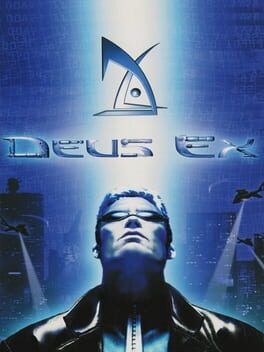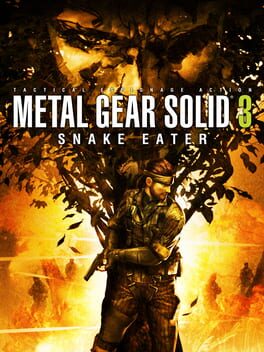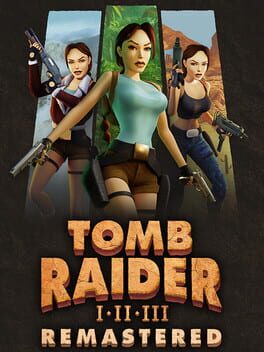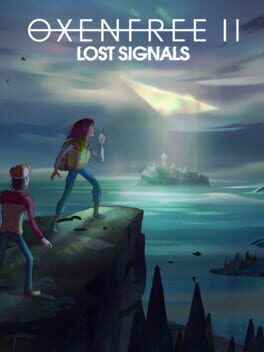thorisalaptop
Bio
Nothing here!
Badges

1 Years of Service
Being part of the Backloggd community for 1 year

N00b
Played 100+ games

On Schedule
Journaled games once a day for a week straight

Gone Gold
Received 5+ likes on a review while featured on the front page

Liked
Gained 10+ total review likes
Favorite Games
185
Total Games Played
007
Played in 2024
002
Games Backloggd
Recently Played See More
Recently Reviewed See More
My basic feelings about Zero Dawn were: "pretty solid open world game with great combat and some chore-like annoyances", but what really kept me engaged in the first game was the lore. I really, really wanted to find out everything about how the world as we know it ended, and how it then became a land of mecha-beasts.
So on the one hand I'd been looking forward to the sequel since it meant revisiting such a cool setting. On the other hand, I wondered if I would find it as engaging since the big mysteries of the apocalypse and re-making of the world were pretty well answered in the previous game so I wasn't sure where the story would go.
Thankfully, Forbidden West has mostly delivered on the promise of the first game. It looks gorgeous, the art design is as strong as ever, and mechanically it's a mild iteration on the formula but that's all that was really needed since Zero Dawn was mechanically great. Narratively, I was not quite as engaged by the "big plot point" here as I was by the mystery of "how we got here" in the first game, but it's still a great story and they definitely found a good way to build on previous story beats to introduce new conflicts and lore elements.
Among open world games, Horizon's combat stands out. Making robots basically stacks of armored components that force you to focus your attacks not just on specific components but with specific types of damage makes combat way more engaging than standard "hit the enemy 'til they die". It also can make different engagements with even the same enemy type very different: are you after an important upgrade component you need to remove, or just aiming for weak points to take down a mob as quickly as you can? And the design of the robots themselves is wonderful, with the different species feeling very distinct and the gargantuan ones inspiring a certain amount of awe every time I run across them. Fighting human enemies in the game is dull by comparison, but thankfully it's not where the game focuses its time.
It's also worth praising that every side-quest in this game is unique, written by a human being, and fully voiced. They're not all the best mission design ever, of course, and the writing ain't Shakespeare, but in an era when many AAA games have tons of copy-paste or procedurally-generated "another settlement needs your help" mission filler, and many big companies seem to be threatening to lean on LLMs for quest generation in the future, it's gratifying to see a big game very definitively not take that approach.
Which doesn't, unfortunately, mean that Forbidden West completely avoids the kind of chore-like bloat open world games are prone too. The sheer, massive number of resources that exist and that you need on a regular basis inevitably means you'll end up doing "chores" for gear upgrades. It also kind of clouds the sense of the world as a real place: rather than adding detail, having a million similar-sounding resources to collect just turns the crafting elements into a blur of checkboxes and "number go up".
But overall I had a blast and enjoyed revisiting the post-apocalyptic West. Forbidden West takes the strengths of Zero Dawn and successfully builds on them, so I can forgive that it continues to have some of the same annoying weaknesses of both its predecessor and its general genre.
Slightly spoiler-y plot complaint: I was not expecting the third act reveal that Ted Farro turned himself into an immortal Resident Evil-style blob monster, that was cool. But then he was almost immediately killed off-screen and we didn't even get to see the monster he became, that was disappointing. I was looking forward to a wild boss fight!
So on the one hand I'd been looking forward to the sequel since it meant revisiting such a cool setting. On the other hand, I wondered if I would find it as engaging since the big mysteries of the apocalypse and re-making of the world were pretty well answered in the previous game so I wasn't sure where the story would go.
Thankfully, Forbidden West has mostly delivered on the promise of the first game. It looks gorgeous, the art design is as strong as ever, and mechanically it's a mild iteration on the formula but that's all that was really needed since Zero Dawn was mechanically great. Narratively, I was not quite as engaged by the "big plot point" here as I was by the mystery of "how we got here" in the first game, but it's still a great story and they definitely found a good way to build on previous story beats to introduce new conflicts and lore elements.
Among open world games, Horizon's combat stands out. Making robots basically stacks of armored components that force you to focus your attacks not just on specific components but with specific types of damage makes combat way more engaging than standard "hit the enemy 'til they die". It also can make different engagements with even the same enemy type very different: are you after an important upgrade component you need to remove, or just aiming for weak points to take down a mob as quickly as you can? And the design of the robots themselves is wonderful, with the different species feeling very distinct and the gargantuan ones inspiring a certain amount of awe every time I run across them. Fighting human enemies in the game is dull by comparison, but thankfully it's not where the game focuses its time.
It's also worth praising that every side-quest in this game is unique, written by a human being, and fully voiced. They're not all the best mission design ever, of course, and the writing ain't Shakespeare, but in an era when many AAA games have tons of copy-paste or procedurally-generated "another settlement needs your help" mission filler, and many big companies seem to be threatening to lean on LLMs for quest generation in the future, it's gratifying to see a big game very definitively not take that approach.
Which doesn't, unfortunately, mean that Forbidden West completely avoids the kind of chore-like bloat open world games are prone too. The sheer, massive number of resources that exist and that you need on a regular basis inevitably means you'll end up doing "chores" for gear upgrades. It also kind of clouds the sense of the world as a real place: rather than adding detail, having a million similar-sounding resources to collect just turns the crafting elements into a blur of checkboxes and "number go up".
But overall I had a blast and enjoyed revisiting the post-apocalyptic West. Forbidden West takes the strengths of Zero Dawn and successfully builds on them, so I can forgive that it continues to have some of the same annoying weaknesses of both its predecessor and its general genre.
Slightly spoiler-y plot complaint: I was not expecting the third act reveal that Ted Farro turned himself into an immortal Resident Evil-style blob monster, that was cool. But then he was almost immediately killed off-screen and we didn't even get to see the monster he became, that was disappointing. I was looking forward to a wild boss fight!
A fun nostalgia trip and also a reminder that you can never really go home again.
To start, as a remaster this is pretty good but also kind of basic and has some notable flaws. The graphics upgrades are nice: it looks "retro" while also being much easier on the eyes than the original graphics. It's kind of a "looks how you remember instead of how it actually looked" kind of thing. I do also appreciate that the original graphics are a button press away, if only as a reminder that those blocky tiles that looked great on a 17" CRT really don't cut it on a 55" OLED. The original graphics would probably look better if they'd let them run at 60 FPS, but they don't for some reason, and even for 30FPS they feel jittier or jerkier than they should.
The modern controls, which have prompted much discussion since release, were a nice idea but are bad in practice. Fundamentally, the early TR games are precision platformers with many puzzles built around the nuances of the tank controls, and if you can't set up your jumps exactly you're gonna get frustrated. The modern controls can still do most of the maneuvers you'd need to do (hop back, back flip, and so on), but they were all flakey for me and trickier to execute than with the tank controls. I still don't think there's a way to side-step. Even if you do end up preferring the modern controls, there's no official explanation of how they work AFAICT, and they work kind of weird in some ways. E.g. separating "interact with item" (action) from "fire weapon" (labeled "secondary" in the menu) makes some sense, but if you're separating those why would you put "grab" on secondary? I'm no fan of tank controls, and it took me a little while to get used to them again, but ultimately I think in this case the original tank controls are more effective and less frustrating than this clumsy attempt at modernization.
The modern graphics do also have a few issues. Mostly legibility: there were several cases where the new sprites for keys you need to pickup were very difficult to see against the tiles they sat on, with very low contrast and the keys themselves being smaller than the original. Unless you remember where all the key items are or are using a walkthrough, I think it's easy to miss an item and get a bit lost some places. The lighting can also be a bit weird: areas in TR2 that were pitch black to encourage use of flares are merely "dim" now, which isn't a huge deal but does change how you play the game and make flares even less necessary. I also hit a weird bug at the end of TR2 where I couldn't grab the dagger out of the dragon's heart on modern graphics, but it worked the first time I tried when I switched to original graphics.
So it's nice, but most of the pitch here is just making these classic games convenient to access on modern platforms.
As for revisiting the games themselves, I enjoyed the trip down memory lane, but I also am reminded that early works in developing mediums/genres/etc. often have some very rough edges and I think that applies here. I am often a little cranky at how homogeneous modern high-budget games can seem, and it's nice to go back to an era when patterns hadn't been as firmly established and things were a little more zany (Lara never fought any dinosaurs in the survivor trilogy, and I kind of miss how acrobatic her movement was in these early games), but on the other hand some of the puzzles are frustratingly obtuse and when combat is challenging it's more because of the clunky controls than good game design. I originally played TR1 when it came out on a PlayStation, meaning there were save crystals, and only a child with effectively unlimited free time could have the patience to get through TR1 with save crystals (and before widespread Internet access made walkthroughs easy to get! I might have had the Prima guide at the time, I can't remember). Nowadays I'm grateful for save scumming and the ability to quickly look up a solution when I'm stuck.
Even with those complaints, there's still a lot to like in these games! As early action-adventure games they're rough around the edges, but they also have a lot of really fun sequences and do a great job of setting up atmosphere within the limits of the technology they had. And my complaints above about obtuse puzzles mostly apply to TR1: TR2 is a much more confidently made game with better level design. Lara Croft is an iconic character who's carried some rough baggage over the years, between being a poster-child for video game culture's toxic objectification of women and then being demoted from "stone-cold uber-competent treasure hunter" to "traumatized grad student" in the survivor trilogy; it's nice to have her early games back with some modern polish.
All of which leaves me glad I dipped back into these games to remind me of my childhood, and also keenly aware that I am no longer that child.
To start, as a remaster this is pretty good but also kind of basic and has some notable flaws. The graphics upgrades are nice: it looks "retro" while also being much easier on the eyes than the original graphics. It's kind of a "looks how you remember instead of how it actually looked" kind of thing. I do also appreciate that the original graphics are a button press away, if only as a reminder that those blocky tiles that looked great on a 17" CRT really don't cut it on a 55" OLED. The original graphics would probably look better if they'd let them run at 60 FPS, but they don't for some reason, and even for 30FPS they feel jittier or jerkier than they should.
The modern controls, which have prompted much discussion since release, were a nice idea but are bad in practice. Fundamentally, the early TR games are precision platformers with many puzzles built around the nuances of the tank controls, and if you can't set up your jumps exactly you're gonna get frustrated. The modern controls can still do most of the maneuvers you'd need to do (hop back, back flip, and so on), but they were all flakey for me and trickier to execute than with the tank controls. I still don't think there's a way to side-step. Even if you do end up preferring the modern controls, there's no official explanation of how they work AFAICT, and they work kind of weird in some ways. E.g. separating "interact with item" (action) from "fire weapon" (labeled "secondary" in the menu) makes some sense, but if you're separating those why would you put "grab" on secondary? I'm no fan of tank controls, and it took me a little while to get used to them again, but ultimately I think in this case the original tank controls are more effective and less frustrating than this clumsy attempt at modernization.
The modern graphics do also have a few issues. Mostly legibility: there were several cases where the new sprites for keys you need to pickup were very difficult to see against the tiles they sat on, with very low contrast and the keys themselves being smaller than the original. Unless you remember where all the key items are or are using a walkthrough, I think it's easy to miss an item and get a bit lost some places. The lighting can also be a bit weird: areas in TR2 that were pitch black to encourage use of flares are merely "dim" now, which isn't a huge deal but does change how you play the game and make flares even less necessary. I also hit a weird bug at the end of TR2 where I couldn't grab the dagger out of the dragon's heart on modern graphics, but it worked the first time I tried when I switched to original graphics.
So it's nice, but most of the pitch here is just making these classic games convenient to access on modern platforms.
As for revisiting the games themselves, I enjoyed the trip down memory lane, but I also am reminded that early works in developing mediums/genres/etc. often have some very rough edges and I think that applies here. I am often a little cranky at how homogeneous modern high-budget games can seem, and it's nice to go back to an era when patterns hadn't been as firmly established and things were a little more zany (Lara never fought any dinosaurs in the survivor trilogy, and I kind of miss how acrobatic her movement was in these early games), but on the other hand some of the puzzles are frustratingly obtuse and when combat is challenging it's more because of the clunky controls than good game design. I originally played TR1 when it came out on a PlayStation, meaning there were save crystals, and only a child with effectively unlimited free time could have the patience to get through TR1 with save crystals (and before widespread Internet access made walkthroughs easy to get! I might have had the Prima guide at the time, I can't remember). Nowadays I'm grateful for save scumming and the ability to quickly look up a solution when I'm stuck.
Even with those complaints, there's still a lot to like in these games! As early action-adventure games they're rough around the edges, but they also have a lot of really fun sequences and do a great job of setting up atmosphere within the limits of the technology they had. And my complaints above about obtuse puzzles mostly apply to TR1: TR2 is a much more confidently made game with better level design. Lara Croft is an iconic character who's carried some rough baggage over the years, between being a poster-child for video game culture's toxic objectification of women and then being demoted from "stone-cold uber-competent treasure hunter" to "traumatized grad student" in the survivor trilogy; it's nice to have her early games back with some modern polish.
All of which leaves me glad I dipped back into these games to remind me of my childhood, and also keenly aware that I am no longer that child.









